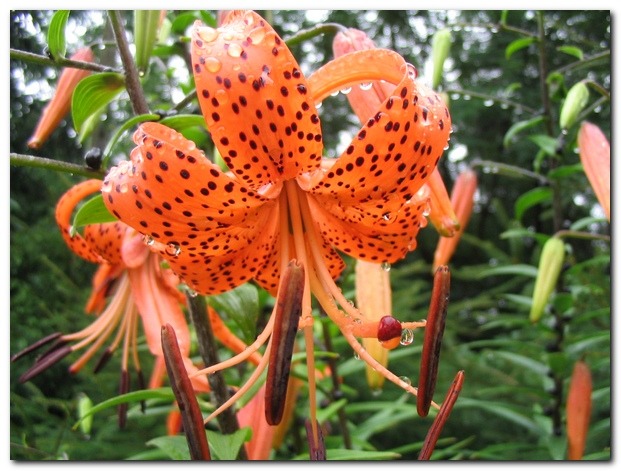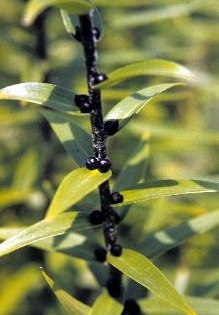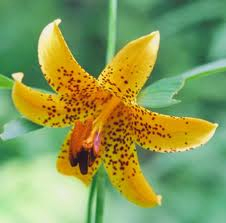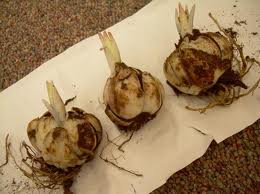The word “lily” causes more confusion than four letters ought to be able to make. There are true lilies, usually not edible, some of them quite toxic, a few edible. And there are plants people call lilies which aren’t lilies at all, some quite toxic and some edible. The next layer of confusion comes from the fact many people call many different plants the same name, in this particular case, the Tiger Lily.
The Tiger Lily we’re interested in for the moment is Lilium lancifolium, a native of Asia and Japan but naturalized in the northeast quadrant of North America, and a few other places as well. Most of this Tiger Lily is edible by humans but all parts are toxic to cats. It causes feline kidney failure. In Asia and Japan this lily is grown for its edible bulb. Cooked it resembles turnips in flavor. Flower buds are eaten raw or cooked.
This particular species does not produce seeds. Instead it produces little black bulbs (bulbils) where the leaves meet the stem. You can use those to propagate the lily or the tubers. However, by bulbil it takes three years for them to mature.
Now we get to the pseudo-controversy. All over the Internet there are dire warnings that the pollen of Lilium lancifolium (aka Lilium tigrinum) is toxic, that is, it will make humans throw up and generally be miserable. Oddly, none of the books in my library, except for one, mentions the pollen at all. Save for that one entry none of my foraging books mention pollen nor do any of my flower books mention it. In fact none of my books on poison mention Lilium lancifolium pollen regarding humans. The one reference I have to the pollen is found on page 512 of the Encyclopedia of Edible Plants of North America by Dr. Françoís Couplan. In reference to Lilium lancifolium and Lilium bulbiferum he writes:
“The pollen can be gathered in relatively important amounts and eaten as such or sprinkled over various dishes. It is nutritious and has a pleasant taste.” The Internet seems to be in disagreement with Dr. Couplan, who has a PhD in ethnobotany. His encyclopedia was published in 1998.
Cornucopia II, which is a compendium of edible plants in the world, also published in 1998, says on page 144 of the Lilium lancifolium: “Flowers both fresh and dried eaten in soups, salads…” No mention of or warning about avoiding the pollen on fresh flowers. It would seem the Internet is at odds with Cornucopia II as well.
The Internet is rife with misstatements. The pollen-is-bad-for-humans warning could have risen out of the real threat it poses to cats. They lick lily pollen off their fur and often die from it. That warning could have morphed from fatal for cats to toxic for humans. There are previous examples with other plants.
Many sites in the last five years have published the warning that pine needle tea can cause abortions in humans, another leap from a known threat animals to certain problem for humans. It started with an article in the Journal of Animal Science (J ANIM SCI 1992, 70:1604-1608.) In the article cows in or after their eighth month of pregnancy which ate several pounds of Ponderosa pine needles did indeed have abortions, the rate ranging from 5 to 8%. Non-pregnant cows were not affected. The article did not cause much alarm as the Internet was in its informational infancy in 1992. However, the United States Department of Agriculture issued a report on the Internet in 2006 — still on line — saying “Ponderosa pine grows in all of the states west of the Great Plains and in western Canada. Pine needles can be made available to cattle from slash remaining after logging operations, windfalls, or dried fallen needles. Discarded Christmas trees have been known to cause abortions in cows. Lodgepole pine (P. contorta), common juniper (Juniperus communis), and Monterey cypress (Cupressus macrocarpa) also contain isocupressic acid and may also cause abortions when eaten by cattle.”
One blog that same year mentioned the cow problem then made the leap by saying Native Americans knew long ago what modern scientists had only recently learned about pines needles and abortions. The blog added the element of Indian woman using pine needles for abortions — no reference given. Included in the blog was one additional comment about pines from the ancient Greeks and the warning was born. From there it proliferated over the Internet. Now pine needles cause abortions in humans, each reference becoming obligatory and more dire. Can you intentionally prepare pine needles to somehow affect a pregnancy in humans? Perhaps, though there seems to be no examples in the medical literature. Then again, too much of anything can probably affect a pregnancy, wine comes to mind. Intentionally preparing an intense dose of pine needles is far different than two pine needles sitting in hot water making a pleasant tea with Vitamin C.
In another example other sites have being saying the aril of the Momordia charantia is toxic to kids. It’s nearly 100% lycopene, not exactly a toxic substance. If it is toxic to children then maybe watermelon is, too. Professor Julia Morton, an expert on edible and toxic plants in Florida, wrote extensively about the species many times and never made mention of anything related specifically to children. I can remember finding the original site that said the arils were toxic to kids. Again, no reference was given. Last year I met a breast-feeding mom who ate them and kept right on feeding.
So, is the pollen of the Lilium lancifolium, toxic to humans? The books say nothing bad about it, Dr. Couplan says it tastes good and can be collected in quantity, the Internet says it is toxic to humans. Can we find a way that toxic view could have been proliferated? Yes, the plant is toxic to cats. It is a short leap for amateur writers to include humans. I wrote to Dr. Couplan for his opinion on this. He wrote back saying he has consumed Lilium lancifolium pollen in small amounts with no known bad effects. Dr. Couplan asked for a reference on the purported toxicology of Lilium lancifolium on humans. I could not and cannot provide one because I can’t find one, published that is. As best I can tell it is Internet rumor and one reason why I prefer published references.
Among the native lilies of North America the cooked bulbs of the follow species can be eaten by humans: Lilium canadense, (now rare in some places) Lilium columbianum, Lilium occidentale, Lilium pardalinum, Lilium parvum, Lilum philadelphicum and Lilium superbum. Yes. Superbum (soo-PER-bum) It means superb. Another edible Asian lily is Lilium bulbiferum.
Lilium is dead Latin for the Greek word Lirion, which means lily. Now days they’re called Krinos — meaning lily — which is also a brand of imported Greek food. That said, lilies get around. A few years ago I had the opportunity to visit the Palace of Knossos near Heraklion, Crete. In the museum is the famous “lily” vase, a fresco that dates back 3,500 years. A similar fresco in the same time frame is found on the Greek island of Thera, though it is better known as Santorini. The working theory is the volcanic eruption that essentially destroyed Santorini created a tidal wave that wiped out the Minoans at Heraklion a few hundred miles away. The Minoan civilization never recovered from that disaster. The frescos did.
Lastly, don’t you think it is odd that the plant is called the Tiger Lily not the Jaguar Lily? Jaguar are orange and have spots, orange tigers have stripes. Maybe the Tigris river had something to do with it.
Green Deane’s “Itemized” Plant Profile
IDENTIFICATION: Bulbs widely ovoid, large scales. Stems minutely woolly, purplish, buds usually flat-sided, somewhat triangular in cross section. Leaves scattered, horizontal and drooping at tips; dark purple axillary bulbils; leaves lanceolate, often narrowly so, edges not wavy. Flowers hang down, not fragrant; Turk’s-cap-shaped; sepals and petals curve back, orange with many purple-brown spots; stamens stick out, ends purplish,
TIME OF YEAR: Late summer
ENVIRONMENT: Near damp places in urban areas, roadsides, railroad banks, buildings.
METHOD OF PREPARATION: Bulbs boiled, pickled, or used to make starch. Resemble parsnip in flavor. Flowers both fresh and dried used in soups, salads, omelets and rice dishes.






